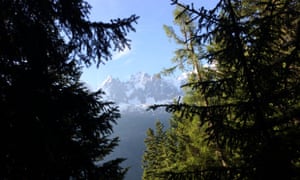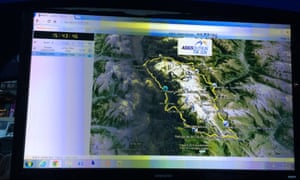Only in the ultra-running community could the notion that two teams race each other, and the sun, the entire way around Mont Blanc between sunrise and sunset be viewed as a sensible suggestion. The route of Outrun the Sun is broadly that of the notorious Ultra-Trail du Mont Blanc (the UTMB) – for which the course record is just over 20 hours. The teams lining up in the Alps last weekend had 15 hours, 41 minutes and 35 seconds to circumnavigate the tallest mountain in Western Europe.
There’s a strange relationship between athletic achievement and global recognition. The world’s most famous footballers – even some athletes, such as Usain Bolt or Mo Farah –are household names. Yet some of the most astonishing feats go virtually unreported. The great names of ultra running, who have performed feats worthy of a rather over-the-top Greek myth – Kilian Jornet, Scott Jurek – could walk unrecognised through pretty much any major city in the world.
And listening to the runners who took part in this race, I realised that ultra runners are mostly loners by nature. How could you not be, to want to spend days on end running through mountain passes, with only marmots and the odd goat for company? These athletes do not run for money or fame. Many are even baffled by the question, “why do you run?” – it’s like asking them why they breathe.

The ultra runners were put into two teams – Team Ultra Trail and Team Enduro. The former comprised experienced – indeed elite – trail runners. The latter team were less experienced in the mountains but with arguably more pure speed, including both elite marathoners and 1500m runners.
The terrain
152km. 9450m accumulated climb. Three countries (no passports required). Snow in the mountains, baking sun heating up the ground lower down. A 10.7 km/hour average pace, which might not sound that fast (it equates to roughly a sub-4 hour marathon) but when you adjust for the terrain, elevation and altitude it’s more like running a 2 hour 30 marathon.
Team Ultra Trail
- 2013 UTMB winner, Xavier Thevenard is 26, looks about 14 and won the CCC (the baby sister, if you can call a 100km mountain race a baby, of the UTMB) at the age of 23.
- Japanese runner Kota Araki was in the Japanese special forces, and won the first marathon he ever ran.
- Swedish runner Jonas Budd has run 100 miles (yes miles) in 12 hours 32 minutes.
- And finally, Thomas Lorblanchet, who won the 2012 Leadville 100, his first 100 mile race.
Quite nippy in the mountains, then, this lot.

Team Enduro
The larger team had shorter stages individually, but the same overall ascent and descent to cover. They weren’t exactly novices either:
- Spanish trail runner and cross-country skier Genis Zapater is a man who says he doesn’t actually own a pair of road-running shoes.
- American trail runner Megan Kimmel lived in a camper van, owned a coffee shop and now works as a gardener, in between managing to fit in winning quite a lot of races.
- French runner Sylvaine (Sissi) Cussot is fairly new to the sport …
- As is Belgian Gert Theunis, who is actually a Asics employee (the fastest one in the company, which is more of a claim than it would be in most offices)
- Trail-runner Brazilian Iazaldir Feitoza was on his first ever trip to Europe, and was originally a track runner.
- As too was young German 1500m runner Lukas Naegele (a 3m50s PB for that event, and 2 hour 32 minutes for a marathon) who told us that “running is more than just split times and PBs – it’s a feeling”.
- UK marathoner Holly Rush joined the team after Tim Don was forced to pull out, at incredibly short notice. With a marathon PB of 2 hour 37 minutes, she has speed in spades, but had no time to prepare for the tricky terrain– she confessed she was most nervous about the downhill sections. A fall in the World Mountain Trail championships (“I faceplanted!”) had knocked her confidence.
The race
https://youtube.com/watch?v=x38TKalpbVw%3Fwmode%3Dopaque%26feature%3Doembed
At 5.30am, with loud music hyping up the imminent start of the race, the natives of Chamonix must have been rolling their eyes and stuffing in ear plugs. Flares went up, and the runners were off. Within seconds, they were lost to view with only the GPS tracker (acting as a baton in the relay) showing their location on a large screen. From then on, we could only track their progress online – and head to Courmayeur later to watch one of the handovers. It was odd to know that the race was going on and these athletes pushing themselves at ridiculous speeds, while I sauntered around sunny alpine meadows, ran extremely slowly, and had a cold beer at a cafe.
Sun roundly beaten
https://youtube.com/watch?v=71xn8LZRWo0%3Fwmode%3Dopaque%26feature%3Doembed
Team Ultra Trail were ahead of the sun from the very start, and it was quickly clear that barring disaster, they were going to more than meet this crazy challenge. But for Team Enduro, things were a lot closer.
The winning team ran through the tape together that evening a whopping 45 minutes ahead of schedule, looking fresh as daisies. Then the wait was on. It was an odd atmosphere – part celebration, as after all the challenge had been met, and met in style, and part nerves. The GPS tracker was showing that when the last handover, to American Megan Kimmel, took place, she was a good six minutes behind schedule. There was a muted feeling that there was no way this time could be made up.
But as Kimmel neared Chamonix, it was clear she was putting in the most astonishing run. It was hard to judge exact distance, but with around 10km to go, it looked like she had about 33 minutes. That’s fast on the flat, never mind in the mountains. Surely not?
Then 3km. Then 2km. She had six minutes to run the last 2k. OK, it was downhill, but 2km in six minutes? No chance. Clock still relentlessly sticking.
1km. She was on the outskirts of Chamonix. She was by the tennis courts. She was running through town. Her team ran to meet and escort her hime – Brazilian Iazadir acting as a human buffer, sprinting ahead of her, terrifying tourists out of her path. Seconds to go. Then … gone. Sunset. An odd moment where everyone looked up at the still-light sky and internally wondered why on earth Asics hadn’t just hidden the clock – who would have known? “Hey, that’s sport,” said someone. “It’s brutal.” A breath. Then suddenly, barrelling around the corner at a pace worthy of an Olympic sprint final, came the entire team, Megan in the lead, hurling themselves over the line.
https://youtube.com/watch?v=JFOAINlcpBA%3Fwmode%3Dopaque%26feature%3Doembed
They missed the time by 30 seconds. THIRTY SECONDS after more than 14 hours of running. You could not have scripted it: if you had, it would have been rejected. The team disappeared in a scrum of cameras, hugging each other, not too disheartened, just proud of a fantastic achievement.
The goat
To have got so incredibly close and just missed the target must have had every runner on Team Enduro pondering whether if they had just descended that bit faster, cut that corner, they might have done it … Or, in the case of Genis Zapater, perhaps not stopped to assist an animal in need. Yes, while in the middle of a relay race around a mountain, he stopped to help a goat that had got trapped in some netting. Full points for quirky humanitarian (or caprinitarian) style – but you suspect that goat is going to haunt his dreams for some time. Not to mention that every interview he now conducts for the next decade will probably start “Is it true about the goat?”. Rumours that Asics will be calling its next range Le Chevre are unconfirmed. It was a ridiculous, and yet entirely fitting way for such a wonderful, ridiculous and beautiful race to end.
Source: Read Full Article
